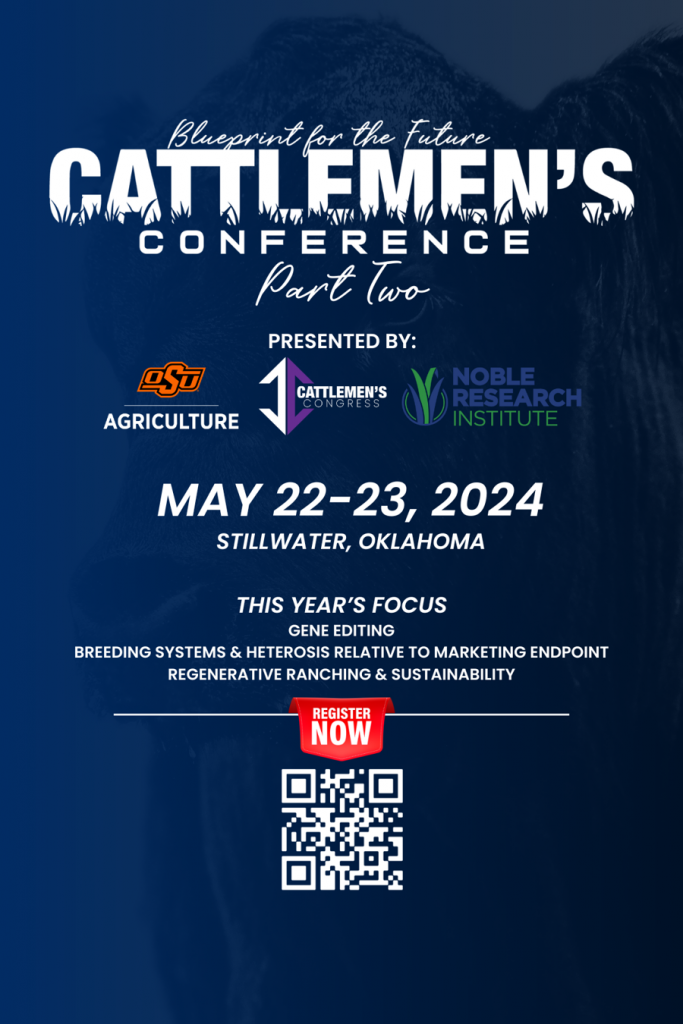Mark Johnson, Oklahoma State University Extension Beef Cattle Breeding Specialist, offers herd health advice as part of the weekly series known as the “Cow Calf Corner,” published electronically by Dr. Peel, Mark Johnson, and Paul Beck. Today, Johnson talks about a cattle producer’s selection and mating program in relation to profit.
One of the most important decisions cattlemen and cattlewomen face today is how to engineer their selection and mating program to add value to their next calf crop. In 2024 we have more genetic information on which to base selection decisions than ever before. Pedigreed, registered seedstock animals are sold with a registration paper documenting their age, pedigree and estimates of their breeding value for over 20 traits. These estimates of breeding value, in the form of EPDs, serve as a roadmap for meeting breeding objectives, improving additive genetic merit and thereby, adding value to your next calf crop.
The mating decision of whether or not to crossbreed in commercial beef herds is effectively the decision of if you want to capitalize on the benefits of heterosis or hybrid vigor. Hybrid vigor is the advantage in performance of the crossbred over the average level of performance of the purebred parents. Hybrid vigor is the result of non-additive genetic merit (or gene combination value) that is created by crossbreeding.
Reproductive traits respond to crossbreeding with high levels of heterosis. Scientific literature indicates well designed, systematic crossbreeding programs lead to crossbred cows weaning as much as 25% more pounds of calves over their lifetime. This is largely due to hybrid vigor giving the crossbred cow an advantage in fertility, reproductive fitness, longevity and maternal performance.
Growth traits are moderately heritable and show moderate levels of heterosis in response to crossbreeding. Carcass traits are highly heritable and show very little heterosis in response to crossbreeding. Marbling, in particular, is primarily the result to additive genetic merit.
So what does this all mean? The intended marketing endpoint of your calf crop (at weaning, as yearlings or as fed cattle on a carcass value system) should have a profound impact on the bull selection and mating decisions you make. How you intend to use a bull (as a terminal sire or a maternal sire) should have a profound impact on your bull selection and mating decisions as well.
This topic will lead off the 2024 Cattlemen’s Conference Blueprint For The Future – Part 2 at OSU on Wednesday, May 22 – 23, 2024. An economic simulation based on current input expenses, the value of calves, yearlings and fed cattle and the impact of additive genetic merit and heterosis on the traits of value at these marketing endpoints will be presented in a panel discussion featuring key industry leaders in the first session on Wednesday, May 22. https://www.cattleconference.com/presenters
The 2024 conference is designed to give cattlemen and cattlewomen the opportunity to network with their peers, attend informative sessions, and learn from industry experts. The beef industry is as complex, ever changing and dynamic as any industry in the world. The objective of this conference is to provide you with the tools and information to thrive in the cattle business. We are hopeful attendees will take advantage of what the conference has to offer and leave feeling inspired and empowered to prepare for the future and take their cattle operation to the next level. Register today at: https://www.cattleconference.com/
Below, Mark Johnson, OSU Extension beef cattle breeding specialist, discusses the upcoming Blueprint for the Future Cattleman’s Conference on SunUpTV from April 6, 2024.


















